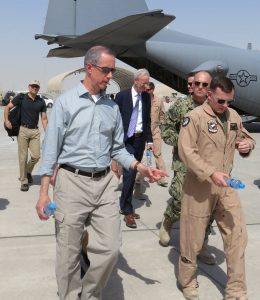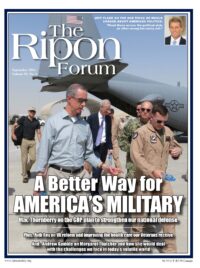
The next President will confront two realities. One is that the world has grown more dangerous under President Obama’s watch. The second is that America’s military is approaching a crisis point. The pace of conflict has remained high for 15 years, but military resources have been cut dramatically. The Pentagon budget for Fiscal Year 2017 is on track to be $100 billion below the level that President Obama’s own Defense Secretary planned for just five years ago. And that was before the rise of ISIS, before China started building islands in the Pacific, before Russia started invading its neighbors, before continual confrontations with the Iranian Navy, and before North Korea stepped up its nuclear and its missile testing.
This mismatch between resources and threats is known as a “readiness crisis.” It means that our military is struggling to meet today’s threats and is less prepared than it should be to meet the threats of tomorrow. It would be convenient to blame one party or president for the current state of affairs. But the truth is that both parties, Congress and the Administration, and civilian and military leadership in the Pentagon have all made decisions that have brought us to this point.
Perhaps the most alarming development, however, has been President Obama’s use of military spending as leverage to gain more domestic spending. Never before has a Commander-in-Chief held the military hostage, arguing that there can be no increase in defense spending unless it is matched dollar-for-dollar with increased domestic spending. This places unacceptable risk on the already burdened shoulders of our military men and women. It is no wonder that friends and allies, as well as adversaries and competitors, look on in astonishment and begin to plan for a post-American world.
We have a critical choice before us, one between continuing to regard defense as just another federal program or giving national security the priority it has traditionally had over the last 70 years.
We have a critical choice before us, one between continuing to regard defense as just another federal program or giving national security the priority it has traditionally had over the last 70 years. These two approaches can be seen in two documents. One is an internal Pentagon memo that was leaked detailing how to gain political advantage in its budget disputes with Congress. The other is the House Republican plan offering dozens of specific policies to restore our defenses, known as “A Better Way.”
The facts show that we have no time to lose. Recently, Army Chief of Staff General Mark Milley said that if we are faced with fighting a peer competitor in the near future, the Army “is not at the levels that can execute satisfactorily … in terms of time, cost in terms of casualties, or cost in terms of military objectives.” The size of the Army has been cut to the lowest level since World War II; training has been deferred; infrastructure is failing; and pay raises have been reduced four years in a row. It is easy to see how the patience of even the most dedicated Army families is being taxed.
The Navy is sailing in similarly dark waters. Global commitments require the U.S. Navy to have 100 ships at sea at all times. In 1998, we had 338 ships to help meet that demand. Today, we are at 272 ships and falling. We have been unable to deploy carriers to the Persian Gulf or to the Pacific for months at a time while the ships we do have are kept at sea longer, wearing them out faster, and making repairs more difficult, time-consuming, and expensive. The result is a vicious cycle of robbing our Navy’s readiness at home to ensure our deploying ships have the parts and equipment they require.
This summer, Captain Scott Robertson, Commander of the USS Normandy, testified to my Committee that, “I have 13 parts that have been cannibalized from my ship to support the current strike group getting ready for deployment…These are all mission items that serve a very specific critical function on board these ships. So 13 of those parts have been taken from my ship over the last month and a half just to get the strike group ready to go.” It is not only ships with which the Navy is struggling. Only 21% of their early model F-18s can fly, while only 50% of their newer F-18s can get in the air due to shortages of spare parts and mechanics.
In 1991, during Desert Storm, the Air Force had 154 fighter and bomber squadrons. Today, even with continued high demand, the Air Force has less than half the resources it did 25 years ago—just 64 fighter and bomber squadrons. It is short 700 fighter pilots, and that number will grow. It is also short of maintainers, which makes it harder to keep our planes in the air, and it robs our pilots of vital training time they need to maintain proficiency and stay safe. As Air Force Colonel Gentry Boswell put it recently, “When I was young coming into the Air Force in the early 90s, we used to make fun of foreign air forces for flying at such a slow rate, and we are slowly but surely walking ourselves into the same problem.”
I came face to face with this readiness crisis in South Carolina this spring. At the Marine Corps Air Station in Beaufort, a Marine showed me the F-18 he was shortly to fly into harm’s way. His jet flew over Libya in the Reagan Administration. To keep it flying today, that same Marine went to the USS Yorktown museum to pull parts off of one of the F-18s they have on display. Today, only two of the 12 Marine F-18 fighter squadrons are meeting their flight hour training requirements. According to FOX News, of the 237 F-18s in the Marine Corps inventory, only 91 can fly. The Marines, as well as the other Services, have seen a disturbing increase in aircraft accident rates.
In the national security portion of “A Better Way,” House Republicans provide dozens of specific proposals to help ensure that the nation can be protected in these perilous times.
In the House, Republicans and Democrats came together to pass a Defense Authorization Bill that begins to turn things around. It also includes substantial reforms to see that the taxpayers get more for their money and that the U.S. is more agile in responding to the proliferation of threats.
But much more needs to be done. In the national security portion of “A Better Way,” House Republicans provide dozens of specific proposals to help ensure that the nation can be protected in these perilous times. You can review them at abetterway.speaker.gov. Defense should never be just another federal program, and it should certainly never be a political bargaining chip. The sacrifices of Americans past and present demand more of us than that.
Mac Thornberry represents the 13th District of Texas in the U.S. House of Representatives. He also serves as the Chairman of the House Armed Services Committee.




